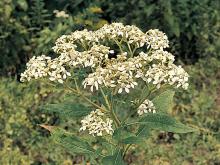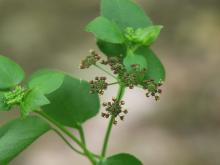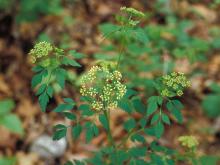Wildflowers, Grasses and Other Nonwoody Plants
Media
Species Types
Scientific Name
Vernonia baldwinii
Description
Ironweeds are tough, grayish-green, branching plants known for their fluffy-looking clusters of reddish-purple florets. They are a familiar sight on roadsides and pastures. Identify western ironweed by the bracts at the base of the flowerheads.
Media

Species Types
Scientific Name
Ageratina altissima (formerly Eupatorium rugosum)
Description
White snakeroot looks very similar to thoroughworts, but it has triangular leaf blades that are more broadly angled or rounded at the base. White snakeroot is common statewide. It’s a toxic plant if eaten, so it’s good to be able to identify it.
Media

Species Types
Scientific Name
Eupatorium perfoliatum
Description
American, or common boneset has small, white flowerheads in flat-topped clusters at the top of the plant. The leaves are hairy, narrowly triangular, and in opposite pairs fused around the stem.
Media

Species Types
Scientific Name
Eupatorium altissimum
Description
A stout perennial that can grow to 6 feet tall, tall thoroughwort is a member of the sunflower family that has dull white flowers and distinctive leaves that are opposite, slender, very short-stalked, and with three quite noticeable veins.
Media

Species Types
Scientific Name
Cirsium altissimum
Description
Tall thistle is a native thistle that can grow to be 10 feet tall! To identify it, notice its leaves, which are unlobed (though they may be wavy or have only shallow, broad lobes), are felty-hairy beneath, and have prickles only along the edges.
Media

Species Types
Scientific Name
Pedicularis canadensis
Description
Wood betony has a tight spiral of tubular, hooded yellow flowers atop a plant adorned with deeply incised, fernlike leaves that are about as attractive as the flowers themselves. In early spring, these leaves have a beautiful wine-red coloration.
Media

Species Types
Scientific Name
Verbesina virginica
Description
White crownbeard is a tall native perennial wildflower with clusters of white flowerheads. It's called “wingstem” for the narrow green wings running along the stem. It’s called “frostweed” because it forms "frost flowers": strange and beautiful formations at the stem bases after a sudden hard frost.
Media

Species Types
Scientific Name
Cunila origanoides
Description
Sometimes called wild oregano, dittany, like true oregano, is a member of the mint family and can be used as a culinary herb and in teas. Look for it on dry, wooded slopes in Ozark counties.
Media

Species Types
Scientific Name
Thaspium trifoliatum
Description
One of our more challenging plants to identify, meadow parsnip looks an awful lot like golden Alexanders. But you can do it! Look closely at the flower clusters and at the edges of the leaves, and then check the seeds.
Media

Species Types
Scientific Name
Zizia aurea
Description
Named for its resemblance to a European herb that was popular in Medieval times, golden Alexanders is a native Missouri wildflower with bright yellow flowers arranged in umbrella-like clusters.
See Also
About Wildflowers, Grasses and Other Nonwoody Plants in Missouri
A very simple way of thinking about the green world is to divide the vascular plants into two groups: woody and nonwoody (or herbaceous). But this is an artificial division; many plant families include some species that are woody and some that are not. The diversity of nonwoody vascular plants is staggering! Think of all the ferns, grasses, sedges, lilies, peas, sunflowers, nightshades, milkweeds, mustards, mints, and mallows — weeds and wildflowers — and many more!





















